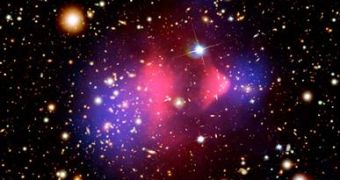Although astronomers believe that dark matter accounts for 25% of the total mass of the Universe, if one asks them how it looks like, he/she will only get a straight face.
So far, it does not emit or reflect enough electromagnetic radiation to be observed directly, so its presence can only be inferred from gravitational effects on visible matter.
Now, a team of astronomers claim to have obtained the proof of dark matter's existence. Researchers from the University of Arizona have been watching a recent collision of galaxies known as the Bullet Cluster and think they have caught a glimpse of this elusive dark matter.
During the collision, the resulting gases slowed more than the galaxies and measurements showed that large amounts of mass that should have fallen behind with the gases continued with the galaxies. Seen in X-rays, the gases interacted electromagnetically, and, without the help of dark matter, their velocity shouldn't have changed more than the stars of the two colliding clusters.
"This provides the first direct proof that dark matter must exist and that it must make up the majority of the matter in the Universe." said study leader Doug Clowe.
So far, observational deductions of the dark matter were made after closely watching and analyzing the rotational speeds of galaxies and orbital velocities of galaxies in clusters, gravitational lensing of background objects by galaxy clusters such as the Bullet cluster, and the temperature distribution of hot gas in galaxies and clusters of galaxies.
The Bullet Cluster is made of two colliding clusters of galaxies, the surrounding gases and the reported dark matter.
"Particularly compelling results were inferred from the Chandra observations of the 'bullet cluster' by Markevitch et al. (2004) and Clowe et al. (2004). Those authors report that the cluster is undergoing a high-velocity [around 4500 km/s] merger, evident from the spatial distribution of the hot, X-ray emitting gas, but this gas lags behind the subcluster galaxies. Furthermore, the dark matter clump, revealed by the weak-lensing map, is coincident with the collisionless galaxies, but lies ahead of the collisional gas. This - and other similar observations - allow good (and interesting) limits on the cross-section of the self-interaction of dark matter," according to a paper by Greg Madejski, Recent and Future Observations in the X-ray and Gamma-ray Bands: Chandra, Suzaku, GLAST, and NuSTAR

 14 DAY TRIAL //
14 DAY TRIAL //